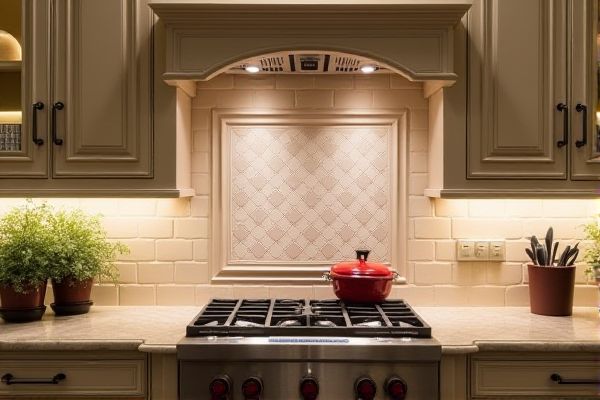
A hood liner provides essential heat insulation and protects your kitchen walls and ceiling from grease and smoke buildup, while a decorative hood primarily enhances the visual appeal of your cooking space without significant functional benefits. Discover how to choose the best option that suits your kitchen's needs and style in the rest of this article.
Table of Comparison
| Feature | Hood Liner | Decorative Hood |
|---|---|---|
| Purpose | Absorbs and controls cooking odors, grease, and smoke | Enhances kitchen aesthetics and provides a decorative cover for vent hoods |
| Material | Typically made from fiberglass, aluminum mesh, or stainless steel | Wood, metal, or custom materials matching kitchen design |
| Maintenance | Requires periodic cleaning or replacement | Needs occasional dusting and maintenance depending on material |
| Installation | Installed inside the hood structure, integrated with ventilation system | Mounted externally as a cover over the hood |
| Functionality | Improves air quality by trapping grease and contaminants | Primarily decorative, may slightly affect airflow if poorly designed |
| Cost | Generally low cost, depends on filter type and brand | Varies widely based on materials and custom design |
Understanding Hood Liners and Decorative Hoods
Hood liners are essential kitchen components designed to protect the interior of your range hood by collecting grease, oil, and smoke, ensuring efficient ventilation and easier cleaning. Decorative hoods serve an aesthetic purpose, enhancing your kitchen's style with various materials and finishes while often housing the functional hood liner within. Understanding the difference helps you choose a hood that balances effective air filtration with your desired kitchen design.
Core Functions: Hood Liners vs Decorative Hoods
Hood liners serve the core function of protecting your kitchen walls and cabinets from grease, heat, and smoke by providing a durable, easy-to-clean surface inside the range hood. Decorative hoods primarily focus on aesthetic appeal, enhancing your kitchen design with various styles and finishes while offering basic ventilation. Choosing between the two depends on whether your priority is functionality and maintenance or visual impact and style.
Material Differences: Performance and Aesthetics
Hood liners are typically made from high-quality, heat-resistant materials such as stainless steel or aluminum, ensuring optimal durability and performance by effectively filtering smoke and grease. Decorative hoods prioritize aesthetics with materials like wood, copper, or custom-painted metals, providing a visually appealing centerpiece while sometimes compromising on filtration efficiency. Your choice between a hood liner and decorative hood depends on whether you value superior performance or style in your kitchen ventilation system.
Installation Considerations for Each Option
Hood liners typically require precise measurements and professional installation to ensure proper fit and ventilation efficiency, often involving cutting appliances and securing with screws or adhesive. Decorative hoods demand attention to style integration and ductwork compatibility, sometimes needing custom fabrication or reinforcement for heavier materials like wood or metal. Both options benefit from consulting manufacturer guidelines to address electrical connections and local building codes.
Design Flexibility and Customization
Hood liners offer high design flexibility by allowing you to customize materials, colors, and finishes to seamlessly integrate with your kitchen's aesthetic while providing essential ventilation support. Decorative hoods serve as striking focal points, often featuring bold designs and intricate details that enhance your kitchen's visual impact but may limit customization options to their predefined styles. Choosing between the two depends on whether you prioritize adaptable design that complements your space or a statement piece that defines it.
Ventilation Efficiency Comparison
Hood liners significantly enhance ventilation efficiency by directing grease, moisture, and smoke through a smooth, insulated surface that prevents buildup and optimizes air flow. Decorative hoods prioritize aesthetics, often lacking the specialized design features needed for effective ventilation, which can reduce air extraction performance. Your kitchen's air quality and safety improve with a hood liner that ensures maximum grease containment and consistent ventilation efficiency.
Maintenance and Cleaning Requirements
Hood liners typically require less maintenance and are easier to clean, as they are designed to trap grease and can be wiped down regularly to prevent buildup. Decorative hoods often feature intricate designs and materials that may need specialized cleaning products and more frequent maintenance to keep their appearance pristine. You should consider your willingness to perform regular upkeep when choosing between a hood liner and a decorative hood for your kitchen.
Cost Analysis: Budgeting for Your Kitchen
Hood liners typically cost less upfront than decorative hoods, making them a cost-effective choice for budget-conscious kitchen remodels. Decorative hoods, while more expensive due to custom designs and premium materials, can add significant value and style to your kitchen space. When budgeting for your kitchen, consider how the initial investment in a decorative hood may enhance overall aesthetics and potentially increase home value compared to the more functional but simpler hood liner option.
Longevity and Durability Factors
Hood liners are typically made from durable, heat-resistant materials that enhance the longevity of your kitchen hood by protecting internal components from grease and moisture damage. Decorative hoods prioritize aesthetic appeal and may use less robust materials, which can impact their durability in high-use kitchens. Choosing a hood liner ensures extended durability and consistent performance, especially in environments with frequent cooking.
Choosing the Right Solution for Your Kitchen Needs
Selecting between a hood liner and a decorative hood depends on your kitchen ventilation requirements and design preferences. Hood liners offer efficient exhaust functionality without drawing attention, ideal for achieving a clean, minimalist look while meeting ventilation standards. Decorative hoods combine visual appeal with performance, making them suitable for kitchens where both style and effective air extraction are priorities.
 homyna.com
homyna.com